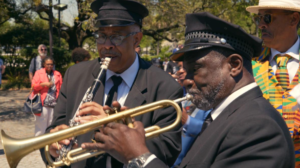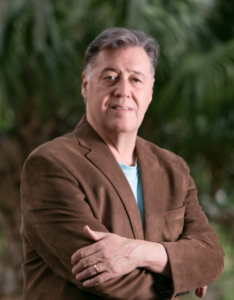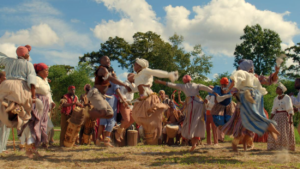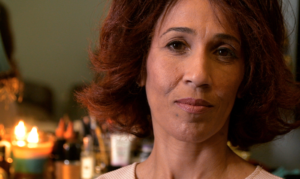Among the many films to be screened at the 2021 New Orleans Film Festival is City of a Million Dreams, a documentary by that examines the evolution of the jazz funeral tradition in New Orleans. Through vintage photos and archival films, historical re-creations and filming of modern-day jazz funerals, the film traces the evolution of the tradition—and New Orleans itself— from the late 18th century to today. From the African rhythms and ring dances of Congo Square to the influence of European marching bands and Sicilian brass bands—along with early 20th-century jazz musicians—to the present-day’s rollicking processions, this epic documentary shows the cultural memory of Black New Orleans and rituals of resilience as never before.
The project, which includes a companion book published under the same title in 2018, was the culmination of 25 years of extensive research and tenacity by investigative reporter, author and filmmaker Jason Berry. He spoke with OffBeat about the circuitous journey from initial concept to the big-screen premiere for a film that took many unexpected turns, including the upheaval of Hurricane Katrina, coverage of the Catholic Church abuse crisis, the unexpected death of a protagonist in the documentary, and, most recently, the pandemic.
You are a native New Orleanian? When did you attend your first jazz funeral?
The first jazz funeral I went to was in 1973. It was for De De Pierce, the grand old man of Preservation Hall, a pianist. It was at Corpus Christi Church. I remember I had seen him before, but I didn’t really know him other than as a spectator. I remember standing outside on the sidewalk watching the coffin come out and the musicians put their instruments up, almost like a military unit putting up swords. The sun was coming down and dancing off the saxophones and the trumpets and the clarinets. It was one of the most beautiful spectacles I’d ever seen. I was mesmerized by it. Then I followed the procession as they put the coffin into the limousine. Then the band moved out. I was walking with the crowd and then they turned on the uptempo music and people danced the soul away.
When it was over, I was walking back to my car and I was just thinking, this is so beautiful. I’ve never seen anything like this. As the years passed, I kept going to funerals. And I did articles about them. I did a long piece when Chief Pete of the White Eagles died. Often I went to funerals, not even with an assignment. I just went and I took notes. I went as part of a community. I went to pay condolences, often for someone I had known, or even if I didn’t know them. Sometimes I went because I thought these are important events to attend. And I began slowly to form the view that these funerals were stories about the city at a given point in time, like moments of history unfolding.
Then when I really started doing the serious research, late nineties, early two thousands, I kept wondering, how did the tradition begin? I knew that Congo Square was a key piece because Sterling Stuckey, in his book Slave Culture, says that everywhere the ring dance is performed, it is an homage to the ancestors. And I realized, okay, these are burial choreographies that have been transplanted after the Middle Passage on the New World soil. So there is this element of life after death in the eyewitness accounts of Congo Square. Of course the people who were writing those accounts weren’t really aware of that. Probably the best example is—I have a chapter on him in the book—the architect Benjamin Latrobe. He has one of the most detailed personal accounts of a visit to Congo Square. What struck me about that was the attention to detail.
There’s a kind of veneer of racial insensitivity—racism would certainly be an accurate term—referring to people as savages and heathens and things like that. But once you peel away the editorializing of the Western eye, you realize that this guy is writing about the transplanting of a profound ritual. Later on, scholars like Ned Sublette and Freddi Williams Evans, in their books, draw the linkages to Kongo—Kongo with a K—as the region where the dance traditions Latrobe was documenting came from.
As all of this material came out, I realized that there was another side to it—namely the brass bands, which are a European tradition. And the metaphor slowly came to me that the ring dances of Africa and the linear processions of the European bands signaled the coming together of the ring and the line. And to me that image, the fusion of the ring and the line of Africa and Europe, defines the cultural essence of New Orleans. It took me many years to understand that. Not only years of going to second lines and funerals, particularly, but also the heavy reading I did over many years to understand the depths of historical memory and the spiritual underpinnings of these traditions.
I had published Up from the Cradle of Jazz in 1986 and I was writing a lot of pieces about New Orleans music for different outlets. I had also been going to jazz funerals for quite a number of years, and I was getting more and more curious about the origins of the tradition. At the same time, through interviews with Dr. Michael White, Gregg Stafford, Milton Batiste and Harold Dejan, I awakened to the realization that this beautiful tradition was being threatened by the drug culture, by the crack epidemic. So many young people—young boys not old enough to vote—were going to early deaths. The second line parades for them, those funeral parades, were quite different from the others.
How was the jazz funeral tradition changing?
The musicians worried about a spirituality being removed from the whole procession with just hard-edge, fiery dancing as a way for people to get their sorrow out. And so I pitched a proposal to the Ford Foundation saying that I was doing research on a book and that I was focused on this conflict between continuity and change. And the grant officer who got back to me was fascinated with the topic. And she told me they weren’t giving research grants for books anymore, but this would be the perfect topic for an oral history, a video oral history.
So I spoke to Bruce Raeburn, then the director at the Hogan Jazz Archive, and I contacted the Payson Center at Tulane. A friend of mine, Bill Bertrand, who had just retired as a chair in public health, he was very interested in it. And so between those two offices at Tulane, I got the institutional support. So for two years there were consecutive grants.
I was interviewing musicians and filming funerals and wakes. The long and short of it was that after all that work was done, I spent a good deal of time working on a treatment and a proposal for a full production at Congo Square. The dramatization of the dances of the enslaved Africans was a center piece of that proposal and treatment.
A guy at the Ford Foundation came back to me and said, Look, you’ve got great footage, this is a fascinating story, but reenactments have a bad odor at PBS. Back then, before Netflix, before streaming outlets, PBS was pretty much where you went. The NEH [National Endowment for the Humanities] basically said the same thing to my proposal, but then a NEH grant officer said, Look, you’ve got all this great research and you want to do a book. And you want to do a film. Why don’t you apply for a Guggenheim Fellowship and write your book? Get the book out and then come back to us. Well at that point I really had nothing to lose. So I applied for the Guggenheim and, to my shock, I actually got it. So I spent almost a year doing a great deal of research. Not only at the Hogan Jazz Archive, but in other libraries and outlets.
I was moving well along with the book. And then in 2002, it was at the end of that year of work when the Boston Globe began its big series on the Catholic clergy crisis, which I had written about in my 1992 book [Lead Us Not Into Temptation]. And within a couple months I had a contract to do a sequel. So the next couple of years I was going back and forth to Rome working on what became the book Vows of Silence. And then I did a documentary on that. Well, in the middle of all that work I was still attending jazz funerals. And occasionally, when I had enough money, filming one. Then Hurricane Katrina hit. I called Dr. Michael White. I was in Plano, Texas, at my sister-in-law’s home. And he was in Houston when we finally connected by cellphone. He told me that he had been on Google Maps and he was pretty certain everything in his house had flooded.

Clarinetist Dr. Michael White, left, and trumpeter Gregg Stafford perform during the 2017 funeral procession for civil rights-era attorney Lolis Elie, in a scene from director Jason Berry’s 2021 documentary about New Orleans funeral traditions, City of a Million Dreams.
So I asked and he agreed to let me film him going into his house, which I did with Philip Braun, a great cameraman who was with me for many of those shoots. So the film grew episodically as I filmed events. And I had a long stretch after that actually doing another book on the Catholic church. And then finally in 2015, Dr. White had regrouped. He had gotten back in a new home and I just decided to put the Catholic Church reporting behind me because I really wanted to finish both the book of New Orleans and the film. And so I began fundraising in earnest toward the end of 2015. The last five and a half years have been a path of production work, halting to raise money, and then more production. And you know, that’s the way documentaries are often made. The big turning point came in 2016 when we did a Kickstarter.
One of the people I had on the Kickstarter list was Bernard Pettingill, a guy I had gone to Jesuit High School with who became a forensic economist in West Palm Beach. He’s done well. And he said, I don’t do Kickstarters, I don’t do charity. And I said, No this is not charity really. I was trying to explain it and he said, Look, how much you need to finish your movie? So I swallowed and gave him a healthy six figure amount. He said, Oh, I can do that. So all of a sudden I had an investor, an executive producer, and he has been extremely helpful in many ways. He really has supported the film through all of the tribulations that came with the COVID, cessation of work as everybody else experienced.
Deb Cotton, another journalist who documented second line parade culture, is prominently featured in City of a Million Dreams. How did you meet her?
I was actually doing a piece for Global Post, a foreign-affairs website which sadly has since gone under. I was doing a piece on the Dalai Lama’s visit to New Orleans, which coincided with that terrible shooting on Mother’s Day at a second line parade in 2013. I started reading about Deb Cotton, who had been shot, and the fact that she had issued a statement from the hospital offering a—how can I put it?—she issued a statement saying that, as a society, we need to look at these young people on the edge and why they were doing things like this. And I was just struck by the compassion.
I made some calls and learned that Deb was in a severe state at the ICU at the University Hospital. And then shortly after that, Linda Usdin, a close friend of hers, made a statement on her behalf to the city council echoing that sentiment of not wanting to be retaliatory toward these men. Not forgiving them, but asking that we see what they had done in a larger social context. It was really profound, too. After Deb stabilized, many surgeries later, I was introduced to her through Mark Hertsgaard, the journalist in the film who speaks about her. Mark and I have been friends for many years. He’s now the head of Covering Climate Now.
He had been coming to New Orleans on assignments dealing with the wetlands and environmental issues. And he was shot in that parade, too. And I saw it on TV that night and I sent him an email saying maybe you’ve left town. Thirty seconds later, I get a response. He says, I’m at the airport. I did get shot, but I’m okay. I’m going back to San Francisco. I’ll call you tomorrow. And we had a long talk. He was hit in the calf, I guess that would be correct. So he as a journalist had a deepening interest in what this was all about. And he got to know Deb and he then introduced me to her. And I originally wanted to film her after she had made that profound statement to the judge at the sentencing hearing of those four young men.
I wanted to film her going into the prison and having a conversation with the guy who shot her. This is beyond what we typically see in films and documentaries. The idea of forgiveness. It’s Shakespearean. It’s like Portia, The Merchant of Venice. The quality of mercy is twice blessed. But that did not pan out. Getting access to the prison posed substantial problems. In the meantime, I was really getting to know Deb and it was a slow process. We hired her as an advisory producer. And as part of that she gave us access to a lot of the video that she had done for her blog about second line parades. We had a good many conversations. I was taking notes. But I wanted to figure out the best way to film a textured interview with her. And at this point we didn’t really know how the film would end. That’s fairly typical for documentaries. Nonfiction films often plunge into a set of events and you follow them through to however they end.
So the dialogue continued until one day I went over to her house for a meeting. It was basically a long pre-interview before we decided where to set up the camera. Where to have her and what she would talk about. She didn’t show up, which is most unlike Deb. She was a very professional person and a good writer. So several days later she called me and apologized. She had an emergency visit to the hospital. Then I began to realize that her condition was more dire than I thought. We continued having our conversations, but I was a little concerned about pressing her to sit down and do an interview on camera when she was dealing with a lot of health issues. And then very suddenly she died.
When she died, we, all of us who knew her, were numb and devastated. And then we realized, okay, we have to film her funeral. We have to do justice to who she was. We did film the funeral and the second line. And then we had to figure out how to end the film. And we knew in some way it had to end with Deb or Lolis Eli, a prominent elder within the Black community who had also died.
For purposes of the film we went back and forth for almost a year trying to figure out the sequence of events. And we had focus groups. And the clear consensus in the focus groups was you need to end the film with Deb’s death. That posed a whole host of other considerations. When you have this… I mean, there are two protagonists. Dr. Michael White searching for his ancestral past after the flood is one theme. And his beautiful music of course surrounds that.
At some of the focus groups, people were crying. Yes. I think some people have wept seeing the end of this film today. We worked very hard to create a final passage or coda to her funeral. I never remotely imagined that the film would end with a person whose life becomes such a dynamic presence to the viewer, so you really do have the experience of going to a funeral of someone you know. This was never anything I imagined we would do. But we did. We had to. We needed to find a tone at the end. And when COVID hit nobody could go out.
So we got footage of the city in the pandemic. And at that point, we began to realize how important murals were. All the murals. One with the phrase We Won’t Bow Down with nurses having the masks across their face. That said so much.
Then finally I went to Dr. White and I said, Look man, we really need a song at the end. Something to bring people up. So he wrote the song that John Boutté then sang in studio, which I think does provide a certain uplift at the end. In keeping with the celebratory response of the second line. But the film is only just out. And I guess in that sense, the jury is still out too. Although thus far the reviews have been quite favorable.
City of a Million Dreams will be screened at the AMC Elmwood Palace 20 on Friday, November 12, at 8:30 p.m. as part of the New Orleans Film Festival. The documentary can also be streamed online through November 22.







